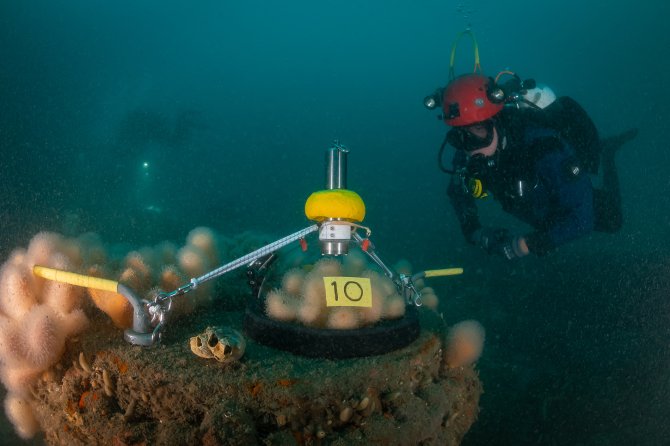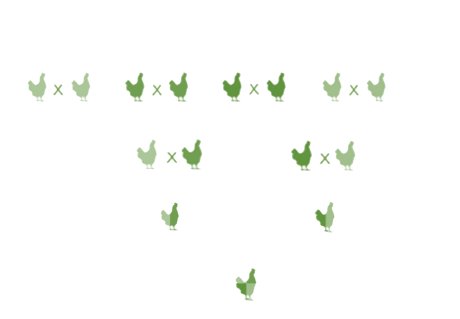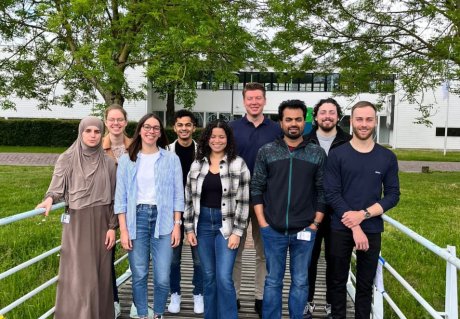
Ecosystem effects of offshore wind parks and other hard structures in the North Sea
WIAS Magazine - Winter edition 2023
Research Overview
Everyone who has ever been at sea knows the feeling of the vast openness of the sea. Floating around in a suddenly very small boat, one experiences how immense and empty our seas are. However, the North Sea is undergoing a rapid transformation. Already visible from the Dutch coast, the sea surface is filling up: The Netherlands are planning to increase the capacity of offshore wind farm energy production from the current 4.7 gigawatt to 70 gigawatt by 2050. Of course, other countries surrounding the North Sea have similar ambitions. The North Sea will definitely not remain the empty space it used to be.
Below the surface of the sea, this transformation might be even more dramatic. The placement of artificial structures like wind turbines is creating hard surfaces in an environment that is otherwise dominated by sand and mud. These surfaces attract numerous marine species, such as mussels, anemones and small shrimps called amphipods, thereby enhancing biomass and biodiversity.
Fouling communities
The groups of species that live on the artificial substrate are called fouling communities and primarily comprised of filter-feeding organisms. Therefore, they play a significant role in many key processes of the marine realm. These organisms filter water for food particles, potentially reducing the water’s turbidity and consequently increasing the amount of light that penetrates the water. At the same time, they produce waste that sinks to the sea floor and can impact the surrounding ecosystem.
However, the consequences of these fouling communities on ecosystem processes such as nutrient cycling or the food web remain unclear. Understanding the effects resulting from the introduction of these artificial structures is crucial for proper management of the North Sea as its transformation will continue over the coming decades. Together with other people working on the ASSESS project, I hope to shed some light on the effects on the ecosystem caused by the presence of these fouling communities.
Diving for data
But how one can assess the long-term effects when most wind parks are either constructed very recently or yet to be built? Fortunately, there are two types of artificial hard structures that have been around for some time: shipwrecks and production platforms. I use them as models for the future effects of wind parks. Last year, my supervisor Joop Coolen and I spent a lot of time diving on these structures. We placed sensors that measure parameters such as oxygen concentration or turbidity within a part of the community enclosed by our self-developed “dome” (an in-situ incubation chamber). To determine nutrient concentrations (e.g., nitrate, phosphate), we also took water samples. After the measurements, we scraped off all fouling organisms and took them to the lab, where we identified, counted, and weighted the species. The data gives us information on the clearance rate of the filter-feeders and their respiration, as well as processes related to the carbon and nitrogen cycle occurring within these communities.

Joop Coolen during the deployment of the dome on a shipwreck in the North Sea (Photo by Joost van Uffelen)
Unravelling the food web
The subsequent step will be to study the structure of the food web. In the coming year, I will visit a production platform to sample as many organisms as possible from the platform and its surroundings. To achieve this, among other methods, we use remotely operated vehicles capable of scraping off fouling communities, nets to collect plankton, and box cores (steel pipes pushed into the ground) to collect animals living inside the sand surrounding the platform. We then use mass spectroscopy to determine carbon and nitrogen isotopic ratios in the tissue of each organism. These ratios indicate the organisms’ position in the food web. I will compare the obtained information on the food web structure to other previous studies on winds parks and natural reefs in the North Sea.
Seasonal and outward effects
Apart from conducting dome measurements offshore and studying the food web, my PhD encompasses two more work packages. One focuses on examining seasonal effects on larval settlement and the processes occurring within fouling communities. We are currently studying this with many small PVC plates mounted in the harbour of Texel. My students and I visit the site every two weeks for a whole year to measure parameters using the dome and observe seasonal changes. My final experiment investigates the impact of fouling communities on the surrounding sand. As the fouling organisms excrete waste that falls down onto the seabed, they might influence the flow of energy through the ecosystem, altering the dynamics in comparison to the “normal” sandy environment.
Ultimately, by doing all of this to better understand the dynamics between fouling communities and the surrounding ecosystem, we hope to gain insights that can inform better management practices for human-made structures such as wind parks in the North Sea.




